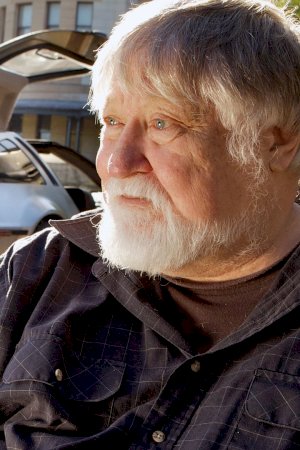Ron Cobb

Ron Cobb
Ron Cobb (born 1937) is an American cartoonist, artist, writer, film designer, and film director. By the age of 18, with no formal training in graphic illustration, Cobb was working as an animation "inbetweener" artist for Disney Studios in Burbank, California. He progressed to becoming a breakdown artist on the animation feature Sleeping Beauty (1959). (This was the last Disney film to have cels inked by hand.) After Sleeping Beauty was completed in 1957, Disney laid off Cobb and he spent the next three years in various jobs — mail carrier, assembler in a door factory, sign painter's assistant — until he was drafted in 1960 into the US Army. For the next two years he delivered classified documents around San Francisco, then, after signing up for an extra year to avoid assignment to the infantry, was sent to Vietnam in 1963 as a draughtsman for the Signal Corps. On his discharge, Cobb began freelancing as an artist. He began to contribute to the Los Angeles Free Press in 1965. Edited and published by Art Kunkin, the Los Angeles Free Press was one of the first of the underground newspapers of the 1960s, noted for its radical politics. Cobb's editorial/political cartoons were a celebrated feature of the Freep, and appeared regularly throughout member newspapers of the Underground Press Syndicate. However, although he was regarded as one of the finest political cartoonists of the mid-1960s to early 1970s, Cobb made very little money from the cartoons and was always looking for work elsewhere.His cartoons were featured in the back to the land magazine "The Mother Earth News." Among other projects, Cobb designed the cover for Jefferson Airplane's 1967 album, After Bathing at Baxter's. He also contributed design work for the cult film, Dark Star (1973) (he drew the original design for the exterior of the Dark Star spaceship on a Pancake House napkin). His cartoons from the 1960s and 1970s are collected in RCD-25 (1967) and Mah Fellow Americans (1968) (both Sawyer Press), and Raw Sewage (1971) and My Fellow Americans (1971) (both Price Stern and Sloan). None of these volumes remains in print. In 1969 Cobb designed the Ecology symbol, later incorporated into the Ecology Flag.In 1972, Cobb moved to Sydney, Australia, where his work appeared in alternative magazines such as The Digger. Independent publishers Wild & Woolley published a "best of" collection of the earlier cartoon books, The Cobb Book in 1975. A follow-up volume, Cobb Again, appeared in 1978. In 1981, Colorvision, a large-format, full-colour monograph appeared, including much of his design work for the films Star Wars (1977), Alien (1979), and Conan the Barbarian (1982), the first feature for which he received the credit of Production Designer. Cobb has also contributed production design to the films The Last Starfighter (1984), Leviathan (1989), Total Recall (1990), True Lies (1994), The Sixth Day (2000), Cats & Dogs (2001), Southland Tales (2006), and the Australian feature Garbo, which he directed. Cobb contributed the initial story for Night Skies, an earlier, darker version of E.T.. Steven Spielberg offered him the opportunity to direct this scarier sequel to Close Encounters of the Third Kind until problems arose over special effects that required a major rewrite. While Cobb was in Spain working on Conan the Barbarian, Spielberg supervised the rewrite into the more personal E.T. and ended up directing it himself. Cobb later received some net profit participation. In 1985 Cobb received credit as DeLorean Time Travel Consultant for the film Back to the Future During the early 1990s, Cobb worked with Rocket Science Games. His designs can be seen most notably in Loadstar: The Legend of Tully Bodine (1994) and The Space Bar (1997), in which he designed all the characters.Cobb also co-wrote with his wife, Robin Love, one of the (1985–1987) Twilight Zone episodes. Among the most famous film props signed by Cobb are two of the swords he designed for the 1982 film Conan the Barbarian (the "Father's Sword" and the "Atlantean Sword"). Cobb's original drawings of the swords are nowadays used, in cinema merchandising, to mass-produce and sell replicas.